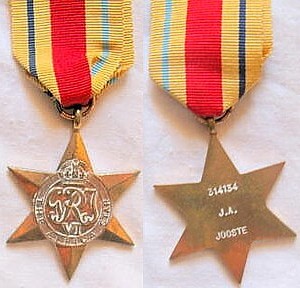
The Africa Star is a military campaign medal, instituted by the United Kingdom on 8 July 1943 for award to British and Commonwealth forces who served in North Africa between 10 June 1940 and 12 May 1943 during the Second World War.

The 1914 Star, colloquially known as the Mons Star, is a British World War I campaign medal for service in France or Belgium between 5 August and 22 November 1914.
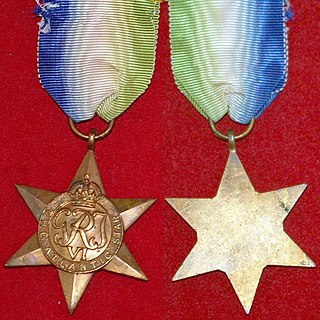
The Atlantic Star is a military campaign medal, instituted by the United Kingdom in May 1945 for award to British Commonwealth forces who took part in the Battle of the Atlantic, the longest continuous campaign of the Second World War.

The 1939–1945 Star is a military campaign medal instituted by the United Kingdom on 8 July 1943 for award to British and Commonwealth forces for service in the Second World War. Two clasps were instituted to be worn on the medal ribbon, Battle of Britain and Bomber Command.

The Air Crew Europe Star is a military campaign medal, instituted by the United Kingdom in May 1945 for award to British and Commonwealth air crews who participated in operational flights over Europe from bases in the United Kingdom during the Second World War.
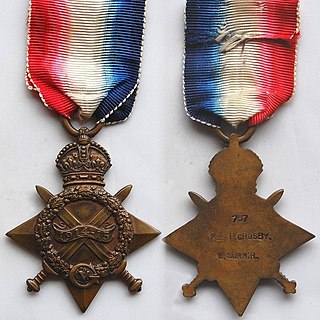
The 1914–15 Star is a campaign medal of the British Empire which was awarded to officers and men of British and Imperial forces who served in any theatre of the First World War against the Central European Powers during 1914 and 1915. The medal was never awarded singly and recipients also received the British War Medal and Victory Medal.

The British War Medal is a campaign medal of the United Kingdom which was awarded to officers and men and women of British and Imperial forces for service in the First World War. Two versions of the medal were produced. About 6.5 million were struck in silver and 110,000 in bronze, the latter awarded to, among others, the Chinese, Maltese and Indian Labour Corps.

The Battle of Ferkeh occurred during the Mahdist War in which an army of Mahdists was surprised and routed by Egyptian forces, led by Sir Herbert Kitchener, on 7 June 1896. It was the first significant action of the reconquest of Sudan, which culminated in the September 1898 Battle of Omdurman.

The Queen's South Africa Medal is a British campaign medal awarded to British and Colonial military personnel, and to civilians employed in an official capacity, who served in the Second Boer War in South Africa. Altogether twenty-six clasps were awarded, to indicate participation in particular actions and campaigns.

The East and Central Africa Medal, established in February 1899, was a British campaign medal awarded for minor military operations in the Uganda Protectorate and Southern Sudan between 1897 and 1899. Four separate clasps were issued.

The Battle of Suakin, occurred on 20 December 1888 during the Mahdist War, when General Francis Grenfell defeated a Mahdist, force near Suakin, a chief port of Sudan.

The Africa General Service Medal, established in 1902, was a campaign medal of the United Kingdom. It was awarded for minor campaigns that took place in tropical Africa between 1900 and 1956, with a total of forty five clasps issued. The medal is never seen without a clasp and some are very rare. Most medals were granted to British led local forces, including the King's African Rifles and the West African Frontier Force. The only campaigns where European troops were present in any numbers were the various Somaliland campaigns,, and in Kenya.

The Egypt Medal (1882–1889) was awarded for the military actions involving the British Army and Royal Navy during the 1882 Anglo-Egyptian War and in the Sudan between 1884 and 1889.

The Queen's Sudan Medal was authorised in March 1899 and awarded to British and Egyptian forces which took part in the Sudan campaign between June 1896 and September 1898.

The Ashanti Medal was sanctioned in October 1901 and was the first campaign medal authorised by Edward VII. This medal was created for those troops engaged in the Third Ashanti Expedition, also known as the War of the Golden Stool. This expedition lasted from March – December 1900, with the final outcome that the Ashanti maintained its de facto independence. Ashanti was made a Protectorate of the British Empire, but they ruled themselves with little reference to the colonial power.

The Khedive's Star was a campaign medal established by Khedive Tewfik Pasha to reward those who had participated in the military campaigns in Egypt and the Sudan between 1882 and 1891. This included British forces who served during the 1882 Anglo-Egyptian War and the subsequent Mahdist War, who received both the British Egypt Medal and the Khedive's Star. Cast in bronze and lacquered, it is also known as the Khedive's Bronze Star.

The Central Africa Medal was a British campaign medal awarded for service from 1891 to 1894 in Eastern and Central Africa, and from 1894 to 1898 for service in British Central Africa.
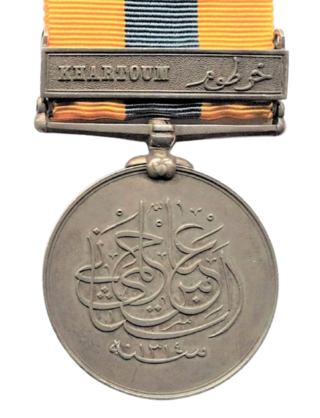
The Khedive's Sudan Medal was a campaign medal awarded by the Khedivate of Egypt to both Egyptian and British forces for service during the reconquest of the Sudan, the final part of the Mahdist War. Established 12 February 1897 by Khedive Abbas Hilmi Pasha, this medal was initially to commemorate the reconquest of the Dongola province in 1896. It was subsequently authorised for later campaigns and actions until 1908. The medal was awarded with fifteen different clasps.

The Victory Medal (South Africa) is the Union of South Africa's version of the Victory Medal (United Kingdom), a First World War campaign medal of Britain and her colonies and dominions. The medal, never awarded singly, was awarded to all those South Africans who were awarded the 1914–15 Star or the British War Medal.
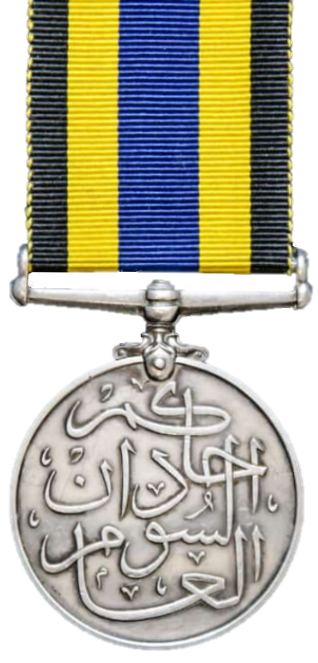
The Sudan Defence Force General Service Medal was a campaign medal instituted in 1933 to reward service in minor operations within the Anglo-Egyptian Sudan. It was last awarded for service in 1941.






















